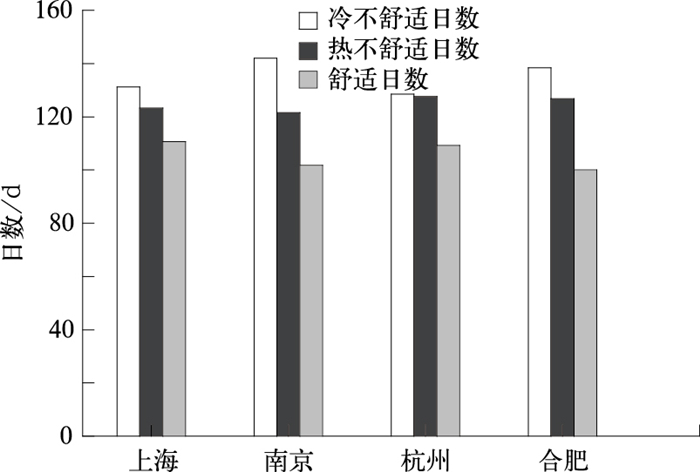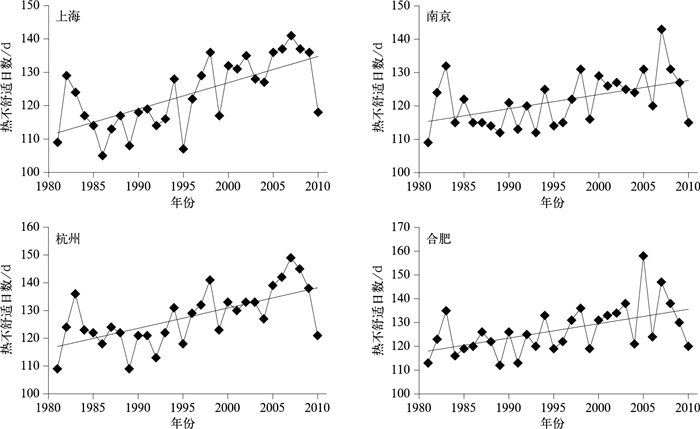Effects of Urbanization on Human Comfort in the Yangtze River Delta
-
摘要: 为研究城市人体舒适度变化和城市化进程的关系,明确影响人体舒适度的主要城市因子,该文首先利用1981—2010年长江三角洲地区上海、南京、杭州、合肥的气象数据,研究气候舒适度及其变化趋势,并研究了影响人体舒适度的主要城市因子。研究结果表明:上海、南京、杭州、合肥冷不舒适日数均呈减少趋势,热不舒适日数均呈增加趋势,舒适日数变化不大。城市化综合水平与冷不舒适日数倾向率之间达到显著相关水平,与热不舒适日数倾向率之间相关不显著。影响长江三角洲地区人体舒适度的最主要城市因子为总人口数量,其次为建成区面积、总用电量、公共交通实有车辆、人均绿地面积等。Abstract: Assessment of urban human comfort is one of hot topics in the field of climate change. Due to rapid urbanization in developing countries, climate issues have gained increasing attention in cities. However, most of these studies are carried out in spatial and temporal variations of human comfort, few considers the effects of urbanization on human comfort. Therefore, the meteorological and urbanization data of Shanghai, Nanjing, Hangzhou and Hefei in the Yangtze River Delta are used to investigate the relationship between urbanization and human comfort, and determine the main urban factors on human comfort. First, the human comfort of four cities in the Yangtze River Delta during 1981—2010 is investigated, and the trends in cold or hot uncomfortable days of four cities are investigated, separately. The results show that Nanjing has the most uncomfortable cold days, while Hangzhou has the least, and Hangzhou has the most uncomfortable hot days while Nanjing has the least. There are downward trends in cold uncomfortable days, the decreasing tendency from large to small is Shanghai, Nanjing, Hangzhou and Hefei. There are upward trends in hot uncomfortable days, and the increasing tendency in descending order is Shanghai, Hangzhou, Nanjing and Hefei. Second, the levels of urbanization of four cities during 1991—2011 are analyzed by the fuzzy comprehensive evaluation, and the relationship between tendency of human comfort and the levels of urbanization are analyzed by the correlation method. The results show that there is a highly significant correlation between the levels of urbanization and the tendency rate of cold uncomfortable days, while no significant correlation is found between levels of urbanization and the tendency rate of hot uncomfortable days. Third, the urban factors on human comfort are investigated by gray relational analysis to determine main urban factors which affect human comfort. It is found that the main urban factor on human comfort is total population, while other more important factors are built-up area, total power consumption, public transportation vehicles, and capita green area.These results suggest that the urbanization of big cities reduce the number of cold uncomfortable days significantly. Urbanization, especially the factors of population increase, city expansion, and traffic congestion energy consumption have profound influences on human comfort of urban residents.
-
表 1 城市不同舒适度日数与各城市发展指标之间的灰色关联分析
Table 1 Grey correlation analysis between the number of different comfort degree days and urbanization indices
城市化体系 指标 灰色关联度 冷不舒适日数 热不舒适日数 上海 南京 杭州 合肥 上海 南京 杭州 合肥 人口类 城市总人口 0.6604 0.4079 0.5737 0.6157 0.7788 0.4591 0.6890 0.6641 地域空间类 建成区面积 0.5445 0.2836 0.3457 0.4947 0.5853 0.3156 0.3830 0.5240 经济类 生产总值 0.4091 0.2878 0.2767 0.3289 0.6765 0.3005 0.2862 0.3538 工业总产值 0.3779 0.2658 0.2363 0.3461 0.3940 0.2799 0.2548 0.3754 能源类 用电总量 0.4659 0.3431 0.2652 0.5112 0.5000 0.3695 0.2941 0.5403 基础设施类 人均园林绿地面积 0.4263 0.2659 0.4555 0.5590 0.4792 0.2978 0.5060 0.5947 人均铺装道路面积 0.3875 0.3327 0.3141 0.4554 0.4331 0.3753 0.3463 0.4988 公共交通实有车辆 0.5712 0.3927 0.3022 0.4424 0.4181 0.4445 0.3373 0.5048 -
[1] 陈群元, 喻定权.我国城市群发展的阶段划分、特征与开发模式.现代城市研究, 2009, 2:77-82. doi: 10.3969/j.issn.1009-6000.2009.02.014 [2] 范业正, 郭来喜.中国海滨旅游地气候适宜性评价.自然资源学报, 1998, 13(4):304-311. http://www.cnki.com.cn/Article/CJFDTOTAL-ZRZX804.002.htm [3] Sookchaiya T, Monyakul V, Thepa S.Assessment of the thermal environment effects on humancomfort and health for the development of novel air conditioning system in tropical regions.Energy and Buildings, 2010, 42(10):1692-1702. doi: 10.1016/j.enbuild.2010.04.012 [4] Mahmoud A H A.Analysis of the microclimatic and human comfort conditions in an urban park in hot and arid regions.Building and Environment, 2011, 46(12):2641-2656. doi: 10.1016/j.buildenv.2011.06.025 [5] 朱燕君, 陈峪, 李庆祥, 等.北京奥运会期间的气象条件分析.应用气象学报, 2006, 17(8):35-41. http://www.cnki.com.cn/Article/CJFDTOTAL-YYQX2006S1004.htm [6] 郑有飞, 尹继福, 吴荣军, 等.热气候指数在人体舒适度预报中的适用性.应用气象学报, 2010, 21(6):709-715. doi: 10.11898/1001-7313.20100607 [7] 国家统计局.中国统计年鉴 (1992—2011年).北京:中国统计出版社, 1992-2011. http://www.cnki.com.cn/Article/CJFDTOTAL-SYQY201603027.htm [8] 国家统计局城市社会经济调查总队.中国城市统计年鉴 (1992—2011年).北京:中国统计出版社, 1992-2011. http://www.cnki.com.cn/Article/CJFDTOTAL-SYQY201603027.htm [9] 胡毅, 李萍, 杨建功, 等.应用气象学.北京:气象出版社.2005. http://www.cnki.com.cn/Article/CJFDTOTAL-SYQY201603027.htm [10] Gulyás Á, Unger J, Matzarakis A.Assessment of the microclimatic and human comfort conditions in a complex urban environment: Modeling and measurements.Building and Environment, 2006, 41(12):1713-1722. doi: 10.1016/j.buildenv.2005.07.001 [11] Thom E C.The discomfort index.Weatherwise, 1959(12):57-60. doi: 10.1080/00431672.1959.9926960 [12] 刘清春, 王铮, 许世远.中国城市旅游气候舒适性分析.资源科学, 2007, 29(1):133-141. http://cdmd.cnki.com.cn/Article/CDMD-10718-1012424427.htm [13] 施能.北半球冬季大气环流遥相关型的长期变化及其与我国气候变化的关系.气象学报, 1996, 54(6):675-683. doi: 10.11676/qxxb1996.070 [14] 张永恒, 范广洲, 马清云, 等.浙江省台风灾害影响评估模型.应用气象学报, 2009, 20(6):772-776. doi: 10.11898/1001-7313.20090617 [15] Sheng G X, Rong D W, Guo H J, et al.Fuzzy comprehensive evaluation on the quality of different mixed feeds for fattening lambs by using in vitro method.Livestock Science, 2008, 115 (2-3):137-143. doi: 10.1016/j.livsci.2007.06.019 [16] 张铁男, 李晶蕾.对多级模糊综合评价方法的应用研究.哈尔滨工程大学学报, 2002, 23(3):132-135. http://www.cnki.com.cn/Article/CJFDTOTAL-HEBG200203032.htm [17] 唐启义, 冯明光.DPS数据处理系统-实验设计、统计分析及模型优化.北京:科学出版社, 2006. http://www.cnki.com.cn/Article/CJFDTOTAL-SYQY201603027.htm [18] 潘敖大, 王珂清, 曾燕, 等.长江三角洲近46 a气温和降水的变化趋势.大气科学学报, 2011, 34(2):180-188. http://www.cnki.com.cn/Article/CJFDTOTAL-NJQX201102009.htm [19] Watkins R, Palmer J, Kolokotroni M.Increased temperature and intensification of the urban heat island:Implications for human comfort and urban design.Built Environment, 2007, 33(1):85-96. doi: 10.2148/benv.33.1.85 [20] 王体健, 万静.长江三角洲地区近50 a的气温变化特征分析.暴雨灾害, 2008, 27(2):109-112. http://www.cnki.com.cn/Article/CJFDTOTAL-HBQX200802004.htm [21] 陈春根, 史军.长江三角洲地区人类活动与气候环境变化.干旱气象, 2008, 26(1):28-34. http://www.cnki.com.cn/Article/CJFDTOTAL-GSQX200801007.htm [22] 谢志清, 杜银, 曾燕, 等.长江三角洲城市带扩展对区域温度变化的影响.地理学报, 2007, 62(7):717-727. doi: 10.11821/xb200707005 [23] 佟华, 刘辉志, 李延明, 等.北京夏季城市热岛现状及楔形绿地规划对缓解城市热岛的作用.应用气象学报, 2005, 16(3):357-366. http://qikan.camscma.cn/jams/ch/reader/view_abstract.aspx?file_no=20050344&flag=1 [24] 段海来, 千怀遂.广州市城市电力消费对气候变化的响应.应用气象学报, 2009, 20(1):80-87. doi: 10.11898/1001-7313.20090110 -


 设为首页
设为首页 加入收藏
加入收藏



 下载:
下载:


